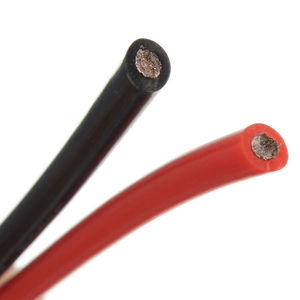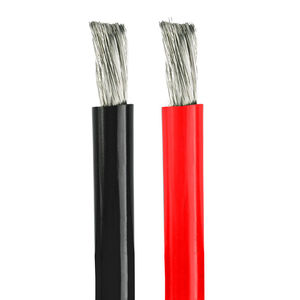
All categories
Featured selections
Trade Assurance
Buyer Central
Help Center
Get the app
Become a supplier

(845 products available)




























china rubber cable flexible tinned copper conductor are an essential component in the realm of electrical equipment and supplies, specifically within the domain of control cables. These cables are designed to transmit electrical signals that control the operation of various equipment and machinery. Typically, china rubber cable flexible tinned copper conductor are composed of multiple conductors, each insulated to prevent interference and ensure precise signal transmission. They are widely used in industrial, commercial, and even residential settings, serving as the backbone for automation systems, power distribution, and communication networks. As technological advancements continue, the demand for efficient and reliable china rubber cable flexible tinned copper conductor has grown, prompting innovations in design and functionality to meet diverse application requirements.
In the expansive world of china rubber cable flexible tinned copper conductor, there are several types tailored to specific applications. Common variants include armored cables, unarmored cables, and flexible control cables. Armored cables are designed with a protective layer that safeguards against mechanical damage, making them suitable for harsh environments. Unarmored cables, on the other hand, offer flexibility and are often used in less demanding settings. Flexible control cables are known for their adaptability and are frequently employed in dynamic applications where movement is involved. Each type of china rubber cable flexible tinned copper conductor is engineered to address particular needs, ensuring optimal performance and longevity in its intended use.
The primary function of china rubber cable flexible tinned copper conductor is to facilitate the transmission of control signals with minimal interference, ensuring accurate and reliable operation of equipment. These cables boast features such as high conductivity, insulation resistance, and durability. High conductivity allows for efficient signal transmission, while insulation resistance prevents signal loss and interference. Durability is critical, as china rubber cable flexible tinned copper conductor often operate in challenging environments, requiring resilience against factors such as temperature fluctuations, moisture, and mechanical stress. Additionally, the flexibility of these cables supports ease of installation and maintenance, making them a preferred choice in many sectors.
The construction of china rubber cable flexible tinned copper conductor involves the use of high-quality materials to ensure performance and reliability. Typically, these cables are made from copper or aluminum conductors, known for their excellent electrical conductivity. The conductors are insulated with materials such as PVC, XLPE, or Teflon, which provide effective insulation and protection against environmental factors. The outer sheath of china rubber cable flexible tinned copper conductor is often constructed from durable materials like PVC or rubber, offering additional protection and flexibility. These materials are selected based on the specific requirements of the application, ensuring that china rubber cable flexible tinned copper conductor can withstand the demands of their operational environment.
Utilizing china rubber cable flexible tinned copper conductor effectively requires an understanding of the specific application requirements and environmental conditions. It is crucial to select the appropriate type and size of cable based on factors such as signal transmission needs, installation environment, and mechanical stresses. Proper installation techniques are essential to prevent damage and ensure optimal performance. In industrial settings, china rubber cable flexible tinned copper conductor are often used in automation systems, where precise control and signal transmission are paramount. In commercial applications, they facilitate communication networks and power distribution. Regular maintenance and inspection of china rubber cable flexible tinned copper conductor can significantly enhance their lifespan and reliability, making them a valuable asset in any electrical system.
When it comes to selecting china rubber cable flexible tinned copper conductor, understanding the specific requirements of your application is paramount. The environment in which the cables will be installed plays a crucial role in determining the type of cable needed. For instance, if the cables are to be used in a setting with high mechanical stress, armored cables might be the best option due to their protective layer. On the other hand, if flexibility is a priority, then flexible control cables could be more suitable. Additionally, considerations such as the number of conductors, insulation material, and the expected load are vital to ensure the china rubber cable flexible tinned copper conductor can handle the operational demands effectively.
Another key factor in choosing china rubber cable flexible tinned copper conductor is their compatibility with existing systems and equipment. It's essential to ensure that the cables can seamlessly integrate with the machinery and devices they are intended to control. This involves verifying the voltage ratings, current capacity, and signal transmission capabilities of the cables. Misalignment in these specifications can lead to inefficient operation or even damage to the equipment. Understanding the technical requirements and working closely with manufacturers or suppliers can help in selecting the most appropriate china rubber cable flexible tinned copper conductor for your needs.
The installation of china rubber cable flexible tinned copper conductor requires careful planning to ensure optimal performance and longevity. It is important to consider factors such as the routing of the cables, the potential for exposure to environmental elements, and the mechanical stresses they may encounter. Properly securing the cables and ensuring they are not subjected to bending or twisting beyond their limits can prevent damage and signal interference.
Determining the right size for china rubber cable flexible tinned copper conductor involves calculating the electrical load they will carry and the distance over which the signal needs to be transmitted. The size of the conductors must be sufficient to handle the current without overheating, while the insulation should be adequate to prevent signal loss. Consulting with an electrical engineer or using industry-standard calculation tools can assist in making the right choice.
Yes, the choice of materials for china rubber cable flexible tinned copper conductor can significantly affect their performance. Conductors made from copper or aluminum are preferred for their excellent conductivity. Insulation materials such as PVC, XLPE, or Teflon offer varying levels of protection against environmental factors and signal interference. Selecting materials that match the operational demands can enhance the reliability and efficiency of the cables.
china rubber cable flexible tinned copper conductor are specifically designed to transmit control signals with high precision, which distinguishes them from power cables that primarily carry electrical power. The construction and materials used in control cables focus on reducing interference and ensuring accurate signal transmission, making them ideal for applications where precision control is necessary.
Regular maintenance of china rubber cable flexible tinned copper conductor involves inspecting them for signs of wear, damage, or corrosion. Ensuring that connections are secure and the cables are free from obstructions can prevent signal loss and interference. It's also advisable to periodically test the cables' performance using diagnostic tools to identify potential issues before they affect operations.